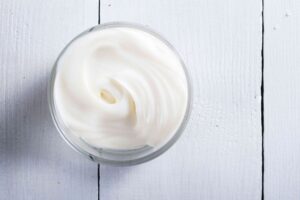:max_bytes(150000):strip_icc():format(jpeg)/Health-GettyImages-1148201277-92af353a428e463f8f4bf5627b176244.jpg)
| Stage of HFMD | Symptoms | Duration |
| Flu-like symptoms | Fever, loss of appetite, sore throat, runny nose | 1-3 days |
| Mouth sores | Painful ulcers or blisters in the mouth, excessive drooling, avoidance of food and drinks | 5-8 days |
| Skin rash | Rash on hands and feet, possible blisters | 5-8 days |
Hand, foot, and mouth disease usually begins with common symptoms of a viral infection, including fever, tiredness, loss of appetite, and runny nose. Because HFMD typically affects the mouth, many children also have a sore throat during this initial stage, which usually lasts for the first one to three days.
While having a fever can be stressful for your child, this stage is often the easiest to manage. If your child is uncomfortable, you can give them age-appropriate doses of Tylenol (acetaminophen) or Advil (ibuprofen) while making sure they get plenty of rest and fluids.
Courtesy of DermNet
Mouth sores may appear shortly after the flu-like symptoms and before the skin rash symptoms, but mouth sores and skin rash symptoms might overlap. Either way, at some point, you will probably see small red ulcers or blisters inside your child’s mouth, most commonly on the sides of the tongue, insides of the cheeks, gums, and roof of the mouth. Some children will only have a few mouth sores, while others have many.
Your child may also lose interest in eating or drinking. The sores are usually painful, and some children drool more than usual or refuse to eat or drink.
Your goal as a parent or caregiver is to alleviate your child’s discomfort as much as possible. You can continue giving appropriate pain medication as needed, and you may want to offer your child plenty of cold drinks or frozen foods (like ice pops), since cold items are less irritating. Avoid anything spicy or acidic. Your child might not want to eat much, but keep them hydrated as much as possible.
Contact your healthcare provider if your child refuses to eat or drink. Dehydration is one of the most common complications of HFMD. Some safe liquid medications for children can coat and numb mouth sores and make it easier for your child to stay fed and hydrated, but these should be given under a provider’s supervision.
Courtesy of DermNet
A skin rash is the final stage of HFMD, which may overlap with the mouth sore stage. The rash usually starts as flat, red spots on the skin and can progress to blisters in some areas. It may be itchy, and the blisters may be painful.
The rash is most likely to appear on:
- Palms of the hands
- Soles of the feet
- Buttocks
- Legs and arms
Your goal at this stage is to manage any existing symptoms, like mouth sores, while ensuring that blisters caused by the rash don’t become infected. Try to discourage your child from scratching or picking at their skin. Allow blisters to heal naturally, keep them clean, and cover them with bandages, if necessary.
If your child seems extremely uncomfortable because of itching, ask your child’s healthcare provider if you can apply an over-the-counter cream containing hydrocortisone or give them an allergy medication such as Benadryl (diphenhydramine) or Zyrtec (cetirizine).
There is no cure or specific treatment for hand, foot, and mouth disease, so there is no way to prevent the disease’s progression. Once you or your child has the virus, it will take its course. You can only try to make the symptoms more comfortable.
In the skin rash stage, though, you can prevent infection by allowing blisters to heal naturally—avoid picking or scratching them. You can also do things to prevent hand, foot, and mouth disease from developing in the first place. This involves practicing basic hygiene and germ prevention strategies.
HFMD is spread person-to-person through coughing and sneezing as well as through stool, so you can prevent its spread and development by doing the following:
- Teach children to cover their coughs and sneezes.
- Wash your hands frequently, especially after using tissues and changing diapers.
- Clean or sanitize heavily used or shared items, like doorknobs, countertops, toys, and books.
- Avoid sharing personal care items like cups, utensils, and bath towels.
- Encourage children with HFMD to distance themselves from their siblings or other young household members, if possible, to prevent sharing germs.
- Keep your hands away from your eyes, nose, and mouth.
If your child has hand, foot, and mouth disease, the most important thing to do is keep them comfortable and hydrated. Try giving them cold items to eat or drink. If they have an appetite, keep foods relatively bland so they don’t irritate mouth sores.
If your child has HFMD, they will likely have to stay home from daycare or school until their fever has gone away and any blisters have dried up to prevent the spread of HFMD. This may take about one week. Have plenty of activities that occupy their time but promote rest, like coloring or sticker books, simple crafts, blocks, puzzles, and some favorite TV shows or movies.
Most children fully recover from HFMD without any special interventions, but there are a few possible complications, including dehydration and viral meningitis. Contact your healthcare provider if your child with HFMD develops any of the following symptoms:
- High fever
- Headache
- Stiff neck
- Excessively dry skin
- Lethargy
- Decreased urine or dark urine
Finally, some people report the loss of fingernails or toenails in the weeks following HFMD. This is an alarming but technically harmless symptom: the nail or nails usually grow back normally on their own.
Hand, foot, and mouth disease (HFMD) is a highly contagious illness caused by the coxsackievirus that commonly affects young children. It usually lasts 7-10 days. Over that time, you or your child will experience different stages of HFMD, each characterized by different symptoms. The three stages are flu-like illness, mouth sores, and skin rash.
While uncomfortable, HFMD is usually not serious. You can treat it at home, and the goal for parents treating their child with HFMD throughout all stages of the illness is to keep them hydrated and comfortable while working to prevent the spread of HFMD to other people.













